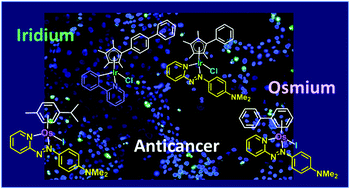当前位置:
X-MOL 学术
›
Metallomics
›
论文详情
Our official English website, www.x-mol.net, welcomes your feedback! (Note: you will need to create a separate account there.)
Pharmaco-genomic investigations of organo-iridium anticancer complexes reveal novel mechanism of action†
Metallomics ( IF 3.4 ) Pub Date : 2017-11-13 00:00:00 , DOI: 10.1039/c7mt00242d Jessica M Hearn 1 , George M Hughes , Isolda Romero-Canelón , Alison F Munro , Belén Rubio-Ruiz , Zhe Liu , Neil O Carragher , Peter J Sadler
Metallomics ( IF 3.4 ) Pub Date : 2017-11-13 00:00:00 , DOI: 10.1039/c7mt00242d Jessica M Hearn 1 , George M Hughes , Isolda Romero-Canelón , Alison F Munro , Belén Rubio-Ruiz , Zhe Liu , Neil O Carragher , Peter J Sadler
Affiliation

|
Resistance to platinum drugs (used in >50% of cancer chemotherapies) is a clinical problem. Other precious metal complexes with distinct mechanisms of action might overcome this. Half-sandwich organometallic complexes containing arene or cyclopentadienyl (Cp) ligands show promise. We screened two iridium(III) complexes [Ir(CpXbiph)(ppy)Cl] (ZL49, 1, ppy = phenylpyridine) and [Ir(CpXph)(azpyNMe2)Cl]PF6 (ZL109, 2, azpyNMe2 = N,N-dimethylphenylazopyridine) in 916 cancer cell lines from 28 tissue types. On average, complex 2 was 78× more potent than 1, 36× more active than cisplatin (CDDP), and strongly active (nanomolar) in patient-derived ovarian cancer cell lines. RNA sequencing of A2780 ovarian cells revealed upregulation of antioxidant responses (NRF2, AP-1) consistent with observed induction of reactive oxygen species (ROS). Protein microarrays, high content imaging and cell cycle analysis showed S/G2 arrest, and late-stage DNA damage response without p53 requirement. The triple-negative breast cancer cell line OCUB-M was highly sensitive to 2 as were cell lines with KIT mutations. Complex 2 exhibits a markedly different pattern of antiproliferative activity compared to the 253 drugs in the Sanger Cancer Genome database, but is most similar to osmium(II) arene complexes which share the same azopyridine ligand. Redox modulation and DNA damage can provide a multi-targeting strategy, allowing compounds such as 2 to overcome cellular resistance to platinum anticancer drugs.
中文翻译:

有机铱抗癌复合物的药物基因组学研究揭示了新的作用机制†
对铂类药物(用于超过 50% 的癌症化疗)的耐药性是一个临床问题。其他具有不同作用机制的贵金属配合物可能会克服这一点。含有芳烃或环戊二烯基 (Cp) 配体的半夹心有机金属配合物显示出前景。我们筛选了两种铱 ( III ) 配合物 [Ir(Cp Xbiph )(ppy)Cl] (ZL49, 1 , ppy = 苯基吡啶) 和 [Ir(Cp Xph )(azpyNMe 2 )Cl]PF 6 (ZL109, 2 , azpyNMe 2 = N,N-二甲基苯基偶氮吡啶)在来自 28 种组织类型的 916 种癌细胞系中。平均而言,复合物2的效力是 78 倍1,比顺铂 (CDDP) 活性高 36 倍,并且在患者来源的卵巢癌细胞系中具有强活性(纳摩尔)。A2780 卵巢细胞的 RNA 测序显示抗氧化反应 (NRF2、AP-1) 的上调与观察到的活性氧 (ROS) 的诱导一致。蛋白质微阵列、高内涵成像和细胞周期分析显示 S/G2 停滞和晚期 DNA 损伤反应,无需 p53。三阴性乳腺癌细胞系 OCUB-M 对2高度敏感,具有 KIT 突变的细胞系也是如此。与 Sanger Cancer Genome 数据库中的 253 种药物相比,复合物2表现出明显不同的抗增殖活性模式,但与锇最相似( II) 具有相同的偶氮吡啶配体的芳烃配合物。氧化还原调节和 DNA 损伤可以提供多靶向策略,使2等化合物能够克服细胞对铂类抗癌药物的耐药性。
更新日期:2017-11-13
中文翻译:

有机铱抗癌复合物的药物基因组学研究揭示了新的作用机制†
对铂类药物(用于超过 50% 的癌症化疗)的耐药性是一个临床问题。其他具有不同作用机制的贵金属配合物可能会克服这一点。含有芳烃或环戊二烯基 (Cp) 配体的半夹心有机金属配合物显示出前景。我们筛选了两种铱 ( III ) 配合物 [Ir(Cp Xbiph )(ppy)Cl] (ZL49, 1 , ppy = 苯基吡啶) 和 [Ir(Cp Xph )(azpyNMe 2 )Cl]PF 6 (ZL109, 2 , azpyNMe 2 = N,N-二甲基苯基偶氮吡啶)在来自 28 种组织类型的 916 种癌细胞系中。平均而言,复合物2的效力是 78 倍1,比顺铂 (CDDP) 活性高 36 倍,并且在患者来源的卵巢癌细胞系中具有强活性(纳摩尔)。A2780 卵巢细胞的 RNA 测序显示抗氧化反应 (NRF2、AP-1) 的上调与观察到的活性氧 (ROS) 的诱导一致。蛋白质微阵列、高内涵成像和细胞周期分析显示 S/G2 停滞和晚期 DNA 损伤反应,无需 p53。三阴性乳腺癌细胞系 OCUB-M 对2高度敏感,具有 KIT 突变的细胞系也是如此。与 Sanger Cancer Genome 数据库中的 253 种药物相比,复合物2表现出明显不同的抗增殖活性模式,但与锇最相似( II) 具有相同的偶氮吡啶配体的芳烃配合物。氧化还原调节和 DNA 损伤可以提供多靶向策略,使2等化合物能够克服细胞对铂类抗癌药物的耐药性。



























 京公网安备 11010802027423号
京公网安备 11010802027423号